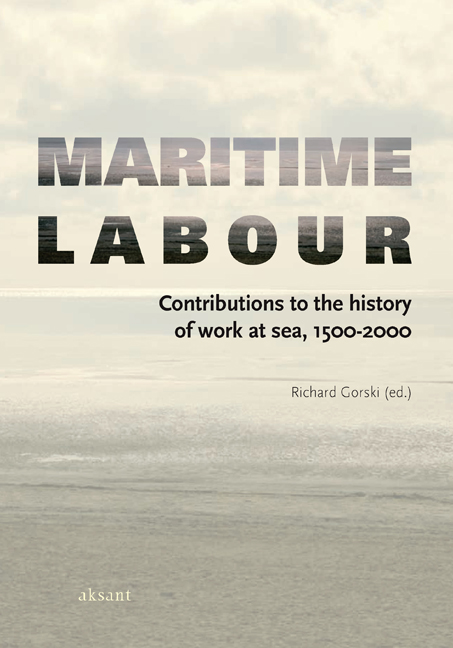Book contents
- Frontmatter
- Contents
- Introduction
- Six Cross-sections of the Dutch Maritime Labour Market: A Preliminary Reconstruction and its Implications (1610-1850)
- On Maritime Labour and Maritime Labour Markets in Germany, 1700-1900
- Swedish Naval Personnel in the Merchant Marine and in Foreign Naval Service in the Eighteenth Century
- Quantifying British Seafarers, 1789-1828
- ‘But for the Loves of the Fishes’: Maritime Labour and Ecological Culture in Nineteenth-century Newfoundland
- The Shipping Federation and the Free Labour Movement: A Comparative Study of Waterfront and Maritime Industrial Relations, c.1889-1891
- Health and Safety Aboard British Merchant Ships: The Case of First Aid Instruction, 1881-1908
- British Merchant Marine Engineer Licensing, 1865-1925
- Transatlantic Fishers: New England and British Trawlermen, 1960-1972
- Masters and chiefs: Enabling globalization, 1975-1995
- About the Contributors
British Merchant Marine Engineer Licensing, 1865-1925
Published online by Cambridge University Press: 26 January 2021
- Frontmatter
- Contents
- Introduction
- Six Cross-sections of the Dutch Maritime Labour Market: A Preliminary Reconstruction and its Implications (1610-1850)
- On Maritime Labour and Maritime Labour Markets in Germany, 1700-1900
- Swedish Naval Personnel in the Merchant Marine and in Foreign Naval Service in the Eighteenth Century
- Quantifying British Seafarers, 1789-1828
- ‘But for the Loves of the Fishes’: Maritime Labour and Ecological Culture in Nineteenth-century Newfoundland
- The Shipping Federation and the Free Labour Movement: A Comparative Study of Waterfront and Maritime Industrial Relations, c.1889-1891
- Health and Safety Aboard British Merchant Ships: The Case of First Aid Instruction, 1881-1908
- British Merchant Marine Engineer Licensing, 1865-1925
- Transatlantic Fishers: New England and British Trawlermen, 1960-1972
- Masters and chiefs: Enabling globalization, 1975-1995
- About the Contributors
Summary
Introduction
When, two centuries ago, engines were first installed in ships, the promoters probably had little appreciation of the impact the new technology would have on ship manning. At a stroke a new and significant craft appeared aboard ships which would rival and outclass such long-standing shipboard skills as seamanship, sail-making, gunnery, cooperage, blacksmithing, shipwrighting and even, when a theoretical basis for ships’ engineering had been developed, navigation. Half a century after their introduction, ships’ engineers were licensed in the same way that mates and masters had been a decade earlier. By the end of the nineteenth century, marine engineers emerged as another of the sub-groups of increasing engineering specialization identified in the formation of professional institutions: Civil Engineering (1818); Mechanical Engineering (1845); Naval Architecture (1860); and Marine Engineers (1889). By 1900, engine room departments of engineers, firemen (stokers) and trimmers (coal passers) on ordinary merchant ships matched in numbers the deck departments of master, mates, and seamen, and on powerful liners greatly exceeded them. Yet merchant ship engineers have been little studied. They were almost invisible if the string of parliamentary publications concerned with shipping safety are to be relied upon, and the vast array of literature concerned with shipping also seems to have largely ignored them.
Concern for safety aboard early steamships was evident in parliamentary investigations and statutes, while steam installations were also covered by general provisions, such as the investigations into boiler explosions. This is an important reminder that ship installations were closely related to power plant ashore in mines, factories and transport, especially the railways. Steamship engineers were equally employable in Britain's burgeoning industries ashore, ensuring that ships were always in competition with a mass of industrial employers ashore for suitably qualified engineering manpower. In contrast to traditional seafarers who were largely locked into their employment afloat, ships’ engineers were always a part of the wider engineering employment scene, able to mix work ashore with that afloat. The early responsibility and leadership roles which came with sea employment made them attractive for responsible positions ashore. The employability of ships’ engineers ashore may also be reflected in the length of their sea careers.
- Type
- Chapter
- Information
- Maritime LabourContributions to the History of Work at Sea, 1500–2000, pp. 185 - 218Publisher: Amsterdam University PressPrint publication year: 2008
- 1
- Cited by



